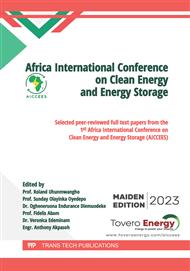[1]
Adedeji, A. O. (2017). Privatization and Performance of Electricity Distribution Companies in Nigeria. Journal of Public Administration and Governance, 7(3)
DOI: 10.5296/jpag.v7i3
Google Scholar
[2]
Allcot H. (2008) Real time pricing and electricity markets. Harvard University. Available at: http://www.erb.umich.edu/HTML-Email/speakers/Post-docCandidates/documents/jmp-allcott.
Google Scholar
[3]
Babatunde, M.A and Enehe, J.M. (2011). Determinants of Household Electricity Demand in Nigeria. Economic and Financial Review, 49(2). 73-97
Google Scholar
[4]
Cochran, W. G. (1977). Sampling Techniques, 3rd Edition (3rd ed.). John Wiley & Sons.
Google Scholar
[5]
Dutta, G., & Mitra, K. (2017). A literature review on dynamic pricing of electricity. Journal of the Operational Research Society, 68(10), 1131–1145
DOI: 10.1057/s41274-016-0149-4
Google Scholar
[6]
Faruqui, A., & Sergici, S. (2009). Household Response to Dynamic Pricing of Electricity - A Survey of the Empirical Evidence. SSRN Electronic Journal. Published. https://doi.org/
DOI: 10.2139/ssrn.1134132
Google Scholar
[7]
Garg, V., Sanchez, L., Bridle, R. & Clarke, K. (2016). How to Pay the Bills? A survey of public attitudes to electricity tariff reform in Rajasthan-. International Institute for Sustainable Development, Canada. Published. https://www.iisd.org/system/files/publications/survey-public-attitudes-electricity-tariff-reform-rajasthan.pdf
Google Scholar
[8]
Gershon, O., & Ezurum, A. (2017). Energy sector governance and cost reflective pricing in West Africa. Retrieved June 2022 from https://aec.afdb.org/sites/default/files/2019/10/08/energy_sector_governance_and_cost_reflective_pricing_in_west_africa.pdf
Google Scholar
[9]
Hosier, R. H., & Dowd, J. (1987). Household fuel choice in Zimbabwe. Resources and Energy, 9(4), 347–361
DOI: 10.1016/0165-0572(87)90003-x
Google Scholar
[10]
Iwuagwu, I. N. (2001). Electricity Pricing in Less Developed Countries: Incorporating Economic Efficiency And Equity Objectives. Nigerian Journal of Technology, 20(1).
Google Scholar
[11]
Kekatos, V., Veeramachaneni, S., Light, M., & Giannakis, G. B. (2013). Day-ahead electricity market forecasting using kernels. 2013 IEEE PES Innovative Smart Grid Technologies Conference (ISGT). Published
DOI: 10.1109/isgt.2013.6497797
Google Scholar
[12]
Lagos State Statistical Survey. (2020). Retrieved on August, 2021 from https://mepb.lagosstate.gov.ng/wp-content/uploads/sites/29/2018/06/Abstract-of-LG-Statistics-2017editted.pdf
Google Scholar
[13]
Masera, O. R., Saatkamp, B. D., & Kammen, D. M. (2000). From Linear Fuel Switching to Multiple Cooking Strategies: A Critique and Alternative to the Energy Ladder Model. World Development, 28(12), 2083–2103
DOI: 10.1016/s0305-750x(00)00076-0
Google Scholar
[14]
Matar, W. (2017). A look at the response of households to time-of-use electricity pricing in Saudi Arabia and its impact on the wider economy. Energy Strategy Reviews, 16, 13–23
DOI: 10.1016/j.esr.2017.02.002
Google Scholar
[15]
Oladipo, F. and Temitayo, O. (2014). The Nigerian Power System till Date: A Review. International Journal of Advance Foundation and Research in Science and Engineering, Volume 1, Number 5
Google Scholar
[16]
Oyedepo, S. O. (2014). Towards achieving energy for sustainable development in Nigeria. Renewable and Sustainable Energy Reviews, 34, 255–272
DOI: 10.1016/j.rser.2014.03.019
Google Scholar
[17]
Salehi, H., Ziari, E.D and Ziaei, M.S. (2017). The Effect of Raising Electricity Price on Welfare of the Household Sector in Rural Areas of Guilan Province, Iran. International Journal of Agricultural Management and Development (IJAMAD), 7(2). 245-255 Retrieved from: http://ijamad.iaurasht.ac.ir/article_527203_6ccad447746d00f225f116633a718472.pdf
Google Scholar
[18]
Statista (2019) Household structure in Nigeria retrieved September 2021 from https://www.statista.com/statistics/1124435/household-structure-in-nigeria-by-area/
Google Scholar
[19]
Tewathia, N. (2015). Explaining the Awareness and Attitude of the Delhi Households in context of Electricity Consumption. MPRA, Paper No. 64854.
Google Scholar
[20]
Zeid M., (2006) Retail Electrical Pricing. Retrieved from http://researchgate.net/publication/ 277006861_
Google Scholar


